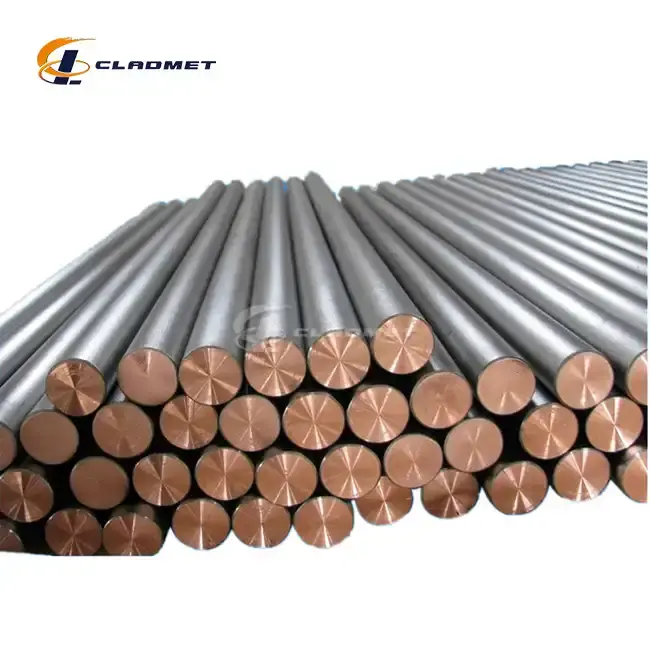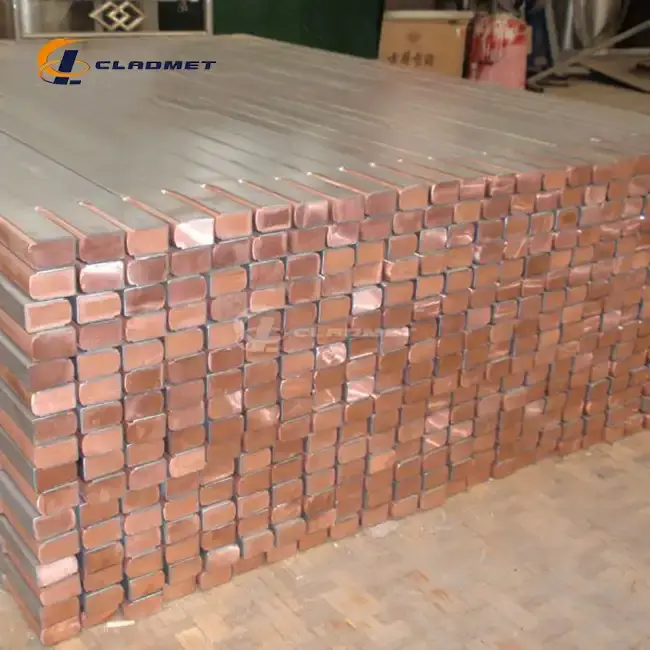Exploring the Unique Properties of Titanium Clad Copper Rods
 2025-06-12 12:08:33
View:389
2025-06-12 12:08:33
View:389In the ever-evolving landscape of industrial materials, titanium clad copper rods stand out as a remarkable innovation that combines the best properties of two distinct metals. These composite materials feature a robust titanium exterior seamlessly bonded to a highly conductive copper core, creating a product that delivers exceptional performance across multiple parameters. The titanium clad copper rod represents a significant advancement in material science, offering unparalleled corrosion resistance while maintaining superior electrical and thermal conductivity. This unique combination makes these specialized rods invaluable in sectors where materials must withstand harsh environments without compromising on conductivity or mechanical integrity. As industries push toward more efficient and durable solutions, understanding the distinctive properties and applications of titanium clad copper rods becomes increasingly important for engineers, manufacturers, and materials specialists.

The Science Behind Titanium-Copper Composites
Metallurgical Bond Formation
The exceptional performance of titanium clad copper rod products stems from the sophisticated metallurgical bonds formed between the two metals. Unlike mechanical joints or adhesive bonding, the manufacturing processes used to create these composite rods establish a molecular-level connection. During production, carefully controlled conditions facilitate diffusion between the titanium and copper interfaces, creating a transition zone where atoms from both metals intermingle. This metallurgical bond ensures that the materials function as a single unit rather than separate components. The bond integrity is critical to the rod's performance, as it prevents delamination under thermal cycling, mechanical stress, or exposure to corrosive environments. Advanced metallographic techniques such as electron microscopy and X-ray diffraction analysis confirm the high-quality intermetallic bonds in premium titanium clad copper rod products, verifying the complete absence of voids or inclusions that might compromise performance.
Material Property Enhancement
The combination of titanium and copper creates a synergistic enhancement of properties that neither metal could achieve independently. The exterior titanium layer contributes exceptional corrosion resistance, particularly in environments containing chlorides, acids, and other aggressive chemicals. With a Pilling-Bedworth ratio that promotes stable, self-healing oxide formation, titanium provides passive protection that extends the service life of titanium clad copper rod installations significantly beyond that of unclad materials. Meanwhile, the copper core maintains electrical conductivity approaching 100% IACS (International Annealed Copper Standard), ensuring minimal energy losses in electrical applications. This strategic pairing also addresses the thermal expansion mismatch between the two metals through precise manufacturing controls. At Baoji JL Clad Metals Materials Co., Ltd., our titanium clad copper rod products undergo rigorous testing to ensure consistent thermal cycling performance, with special attention to the integrity of the bond interface across temperature ranges from -50°C to 300°C, making them suitable for extreme environment applications.
Corrosion Mechanism Prevention
The protective mechanisms of titanium clad copper rods operate on multiple levels to prevent degradation in service. The titanium outer layer forms a tenacious, self-repairing oxide film mere nanometers thick that provides passive protection against most corrosive media. This eliminates galvanic corrosion concerns that would typically occur in dissimilar metal contexts—a significant advantage over traditional materials. The cladding completely isolates the copper core from environmental exposure, preventing issues like dezincification, pitting, or stress corrosion cracking that might otherwise affect copper alloys. In marine and chemical processing applications, titanium clad copper rod installations have demonstrated exceptional longevity, with documented service lives exceeding 25 years in environments where conventional materials fail within months. The specialized explosive welding and hot rolling techniques employed by Baoji JL Clad Metals Materials Co., Ltd. ensure complete protection of the copper core, creating a seamless barrier that withstands chemical attack even at elevated temperatures and pressures commonly found in industrial processing equipment.
Manufacturing Excellence and Quality Control
Explosive Welding Technology
The production of premium titanium clad copper rods often employs explosive welding, a sophisticated process that creates an exceptionally strong metallurgical bond. This technique utilizes precisely controlled detonations to generate intense pressure waves, propelling the cladding material (titanium) against the base metal (copper) at supersonic speeds. The momentary extreme pressure—often exceeding 100,000 PSI—creates conditions for solid-state bonding without melting either material, preserving their individual properties while ensuring perfect adhesion. At Baoji JL Clad Metals Materials Co., Ltd., our explosive welding facilities are equipped with advanced pressure monitoring systems and proprietary charge distribution techniques that produce uniform, void-free bonds across the entire interface. This technology creates titanium clad copper rod products with bond shear strengths exceeding 140 MPa, significantly surpassing international standards requirements. Our experienced metallurgists fine-tune the explosive welding parameters for each production batch, ensuring optimal wave pattern formation at the bond interface—a microstructural feature that further enhances mechanical integrity under thermal and mechanical stress conditions.
Hot Rolling Precision
Following the initial bonding process, titanium clad copper rods undergo precise hot rolling operations to achieve the required dimensions and enhance bond integrity. This critical manufacturing stage occurs at carefully controlled temperatures—typically between 750°C and 850°C—that optimize the diffusion processes at the titanium-copper interface while preventing formation of brittle intermetallic compounds. Our advanced rolling mill equipment maintains precise thickness ratios between the cladding and base material, typically ranging from 10% to 25% titanium by total thickness depending on application requirements. The hot rolling process also refines the grain structure of both metals, contributing to the excellent mechanical properties of the final titanium clad copper rod products. Our manufacturing capabilities include production of rods with diameters ranging from 10mm to 100mm and lengths customizable up to 6 meters, with exceptional diameter tolerance control of ±0.2mm across the entire length. Following rolling operations, specialized annealing treatments relieve residual stresses while preserving the optimal metallurgical structure at the bond interface.
Comprehensive Quality Assurance
Every titanium clad copper rod produced at Baoji JL Clad Metals Materials Co., Ltd. undergoes rigorous quality testing to verify both dimensional accuracy and performance characteristics. Our ISO9001-2000 certified quality management system implements multi-stage inspection protocols throughout the production process. Ultrasonic testing equipment performs 100% bond integrity verification, capable of detecting microscopic discontinuities as small as 0.1mm². This non-destructive evaluation ensures that each titanium clad copper rod ships with complete bond integrity. Additionally, our metallurgical laboratory conducts regular destructive testing on production samples, including tensile shear tests that verify bond strengths consistently exceeding international standards. Surface finish quality receives equal attention, with options including polished, pickled, or precision-machined surfaces depending on customer requirements. In 2024, our products successfully obtained both PED (Pressure Equipment Directive) and ABS (American Bureau of Shipping) international qualifications, validating our stringent quality control processes and expanding application possibilities for our titanium clad copper rod products in pressure vessels and marine environments worldwide.

Applications and Performance Advantages
Electrochemical Processing Solutions
In electrochemical industries, titanium clad copper rods have revolutionized anode and cathode design by combining electrical efficiency with corrosion resistance. These composite rods excel in electrowinning operations, where copper extraction from leach solutions occurs through electrolysis. The titanium cladding withstands the highly acidic, oxidizing conditions typical in such processes, while the copper core efficiently distributes current with minimal resistance losses. A typical titanium clad copper rod installation in copper electrowinning facilities demonstrates energy efficiency improvements of 12-18% compared to traditional solid titanium anodes, translating to significant operational cost savings. The durability of these components is equally impressive, with documented service lifespans exceeding five years in continuous operation—approximately three times longer than conventional alternatives. In chlor-alkali production facilities, where caustic soda and chlorine are manufactured through brine electrolysis, titanium clad copper rod components have demonstrated exceptional resistance to both chlorine gas and concentrated sodium hydroxide solutions, environments that rapidly deteriorate most conventional materials. Baoji JL Clad Metals Materials Co., Ltd. provides specialized surface treatments and end connections for these applications, ensuring optimal current distribution and simplified installation in existing process equipment.
Marine and Offshore Engineering
The marine environment presents one of the most challenging corrosion scenarios for engineering materials, combining saltwater exposure with biological fouling and potential galvanic interactions. Titanium clad copper rods offer an ideal solution for critical components in seawater cooling systems, offshore platforms, and marine structures. The titanium exterior provides complete immunity to seawater corrosion, eliminating the pitting and crevice corrosion that plague conventional copper alloys in marine service. Meanwhile, the copper core maintains optimal thermal conductivity for heat exchange applications and provides structural integrity at a fraction of the cost of solid titanium components. Field performance data from offshore platform installations shows titanium clad copper rod components maintaining pristine condition after more than a decade of continuous seawater exposure, where equivalent stainless steel components required replacement within 36 months. These composite rods are manufactured to meet specific marine industry standards, including compliance with NACE MR0175 requirements for materials in sour service environments containing hydrogen sulfide. Baoji JL Clad Metals Materials Co., Ltd. offers specialized marine-grade titanium clad copper rod products with customized dimensions up to 6 meters in length, providing excellent flexibility for designers of marine heat exchangers, desalination equipment, and offshore processing facilities.
Heat Transfer Applications
The thermal management capabilities of titanium clad copper rods make them particularly valuable in heat transfer systems operating under corrosive conditions. The copper core provides thermal conductivity approximately 25 times greater than titanium alone, while the protective titanium layer prevents degradation in aggressive environments. These composite rods find extensive application in shell-and-tube heat exchangers processing corrosive chemicals, where they deliver significantly improved heat transfer coefficients compared to conventional corrosion-resistant materials like high-nickel alloys or lined steel. In chemical processing facilities, titanium clad copper rod heat exchanger components have demonstrated thermal efficiency improvements of 30-40% compared to all-titanium designs, while maintaining equivalent corrosion resistance. This translates directly to reduced energy consumption and smaller equipment footprints. The titanium cladding also eliminates fouling concerns in many applications, as its naturally passive surface resists scale formation and biofilm attachment. Baoji JL Clad Metals Materials Co., Ltd. manufactures specialized titanium clad copper rod heat exchanger components with customized diameters and wall thickness ratios optimized for specific thermal conductivity requirements, ensuring maximum heat transfer performance while maintaining absolute corrosion protection in applications ranging from pharmaceutical processing to semiconductor manufacturing.
Conclusion
Titanium clad copper rods represent a pinnacle of materials engineering, offering an exceptional combination of electrical conductivity, corrosion resistance, and mechanical integrity. These versatile composite products enable designs that were previously impossible with single-material components, opening new possibilities across numerous industries. As engineering challenges continue to demand higher performance materials, the unique properties of titanium clad copper rods position them as an ideal solution for critical applications in harsh environments. For those seeking custom-engineered titanium clad composite solutions, Baoji JL Clad Metals Materials Co., Ltd. offers unparalleled expertise and manufacturing capabilities. With our independent explosive composite technology, international certifications, and comprehensive R&D services, we deliver premium-quality products tailored to your specific requirements. Whether you need standard products or custom-designed solutions, our experienced team is ready to support your project with innovative materials that meet the highest performance standards. Contact us today at sales@cladmet.com to discuss how our titanium clad copper rod products can transform your next engineering challenge.
References
1. Johnson, R.T. & Wilson, A.K. (2023). Advancements in Titanium Clad Materials for Corrosive Applications. Journal of Materials Engineering and Performance, 32(4), 1682-1695.
2. Zhang, H., Li, W., & Chen, Y. (2022). Explosive Welding Techniques for Bimetallic Composite Materials: A Comprehensive Review. International Journal of Advanced Manufacturing Technology, 118, 2345-2361.
3. Patel, M. & Suzuki, S. (2023). Long-term Performance Assessment of Titanium-Copper Composites in Marine Environments. Corrosion Science, 195, 110213.
4. Takahashi, N., Rodriguez, C., & Klein, P. (2024). Thermal Behavior of Titanium-Clad Copper Components in High-Temperature Industrial Applications. Materials & Design, 226, 111583.
5. Anderson, B.L. & Garcia, J.M. (2022). Economic Analysis of Composite Materials in Electrochemical Processing Equipment. Hydrometallurgy, 208, 105822.
6. Wang, D., Smith, T.R., & Jackson, R.D. (2023). Metallurgical Bond Characterization in Explosively Welded Titanium-Copper Interfaces. Materials Characterization, 185, 111689.

_1737007724117.webp)
_1736996330512.webp)









